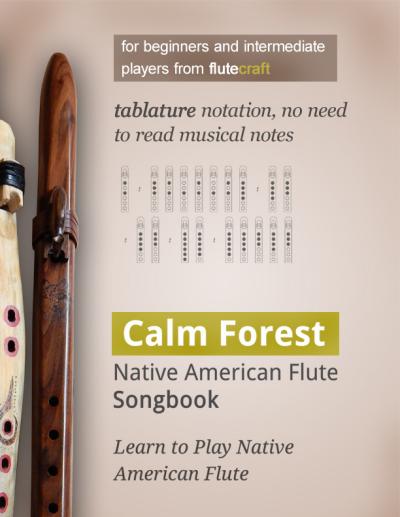Last time you’ve learned how to establish the fundamental note of the flute – so called Key of the flute. Today, in this final tutorial of the series, you will learn how to calculate the finger holes placement, how to make the finger holes, and how to tune everything to the minor pentatonic scale.
Most modern Native American Flutes are tuned to minor pentatonic scale. They have five or six holes, depending on the intentions of the maker.
The Idea Behind Finger Holes
From the previous tutorial you should remember that if you wish to make the flute sound higher, you need to shorten it – and if you wish to make the sound lower, you need to make the flute larger. The finger holes do exactly this – by opening a finger hole, you make the flute shorter – at least you make shorter the way the air has to travel to exit the flute. By covering the finger hole, you make the way air has to travel longer, thus you “make the flute longer”.
This makes the flute capable of playing notes – thus, melodies. The goal is to make sure the finger holes are in the right place so that the notes they play are clear and pleasant to our ears and our brain – this what makes the melody sounds good.
First, you make the holes in calculated points of the flute’s tube – this makes the hole close to a specific note, because the opening makes the tube shorter. Next, in order to make the played note perfect, you use burning tool and small files to enlarge the hole piece by piece – this is the process of fine tuning.
How to Calculate Finger Holes Placement for Native American Flute
We start with doing the math. There is a couple of ways to calculate the finger holes placement for Native American Flute. Some makers just copy it from a template, or from another flute. That said, most beginners just use a plain math – and they place each hole one inch apart. It’s a very simple method to make the flute play the pentatonic scale.
Grab the flute you’re making, and place it in front of you.

Let’s do the math – ignore the ruler – all the numbers are given below :).
Let’s calculate the distance between the True Sound Hole, and the end of the flute. Notice, if your flute has direction holes (tuning holes), you measure the distance between the True Sound Hole (its edge closer to the mouthpiece), and the front face of the tuning holes – the edge closer to the mouthpiece.
- This is important – if you’re making a branch flute, and it’s straight, everything is fine. BUT, it the resonance (sound) chamber is curved, things get complicated. You need to measure the average length between the TSH and the end of the flute in a straight line – because this is the actual length the air has to travel. Unfortunately, there is no easy way to explain it, you just need to gain experience with curved branches.
- Also, remember that we name the finger holes starting with the end of the flute. That means the finger hole that is closest to the end of the flute is the hole number 1, and the finger hole that is closest to the mouthpiece is the hole number 6.
Let’s do the math now (all measures are given in the metric scale):
- Calculate the distance between the north edge of the True Sound Hole (closer to mouthpiece), and the end of the flute (or north edge of the tuning holes). Write it down.
- Divide that number by 2.
- Measure this new distance from the north edge of the True Sound hole down, and mark it. This should give you a point in the middle of the sound chamber (don’t drill it just yet!).
- From that point, measure 6.35 mm south, down the end of the flute and mark this place – this is where hole number 3 goes.
- From hole 3 point, measure 25 mm south – this is where hole 2 goes.
- From hole 2, measure 25 mm south. This is where hole 1 goes.
- Let’s go back – from the hole 3, measure 25 mm north, up to the mouthpiece. This is where hole 4 goes.
- From hole 4, measure 25 mm north – this is where hole 5 goes.
- From hole 5, measure 25 mm north. This is where hole 6 goes.
UPDATE: 08.02.2016:
- Very important update: If your flute’s fundamental notes is B4 or higher (like C5 etc.), and the bore diameter is 18 mm or less, instead of measuring 25 mm between the holes, measure only 20 mm. The holes will be closer to each other, but they will still be tuneable.
- ALSO, in case of these smaller flutes, you should experiment with making 3rd hole become 4th hole. Look at the photo below: just make holes 1, 2, 3, 4 and 5, and tune them like they’re a note higher. So, tune hole 1st as 2nd, 2nd as 3rd and so on – I explain it better below, under the tuning table. In most cases of small flutes, you will have to drill the hole “0”, 20 mm below the 1st hole, and ignore the 6th hole. This way, the entire set of finger holes will be moved down the flute, but they should work out well, without getting an overblow.
- If the 6th hole is too close to the TSH, it will overblow very easily – this is problematic in case of small flutes. That’s why in case of small flutes, you should experiment with shorter distance between finger holes. I usually stick to 20 mm between the holes, and the flutes play nicely.
Take a look at the photo (just don’t drill the holes yet, it’s just for reference):

This should be helpful – the mouthpiece is on the left. We measure the distance from the front edge of the true sound hole to the end of the flute. We count the holes from the end. Hole #1 is close to the end, while hole #6 is close to the mouthpiece.
So far so good – by now you should have a couple of marks on your flute’s body. But – it can’t be that simple, can it? Well:
- If the thickness of the tube’s walls is less than 4.5 mm, all finger holes should be moved north by 3-6 mm.
- If the thickness of the tube’s walls is greater than 4.5 mm, all finger holes should be moved south 3-6 mm.
- If the thickness of the walls is 4.5 mm, you don’t need to do anything.
- If the diameter of the sound chamber is 20-22 mm, three upper holes (numbers 4, 5, 6) should be moved 3-6 mm north.
- If the diameter of the sound is greater than 22 mm, three upper holes should be moved further north.
OK, do the math and mark the holes on your flute.
- If it happens that you wish to copy the placement of the finger holes from another flute, remember – the length of the tube, the thickness of the walls and the diameter of the sound chamber must be exactly the same in both flutes. Otherwise, the placement may not work.
- Using the equal spacing between the finger holes will make them in different diameters – some holes will be bigger, some holes will be smaller. This isn’t a big problem unless you wish to expand your flute’s capabilities into major pentatonic scale and play additional notes.
Now htat we have our holes marked, we can drill them.
Drilling the Holes for Native American Flute
What you need right now is a drill, a burning tool and some small diamond files.
Usa a small drill bit, about 3-4 mm, and drill the holes where you marked them on the flute’s body. We start with small holes, because tuning is usually about enlarging them. The bigger the finger hole, the higher sound it plays. Usually because it’s north edge is closer to the TSH, thus making the sound higher.
Enlarging holes can be done with bigger drill bits – when you use them, enlarge the hole by 1 mm at the time. Thus, if the hole is originally 3 mm wide, use a 4 mm drill bit next and check the tuning of the hole. If it’s not right, use a 5 mm drill bit next. You can also enlarge the hole with electric burning tool. Finally, you can enlarge the hole with fine diamond files and some patience.
Drill slowly. Often, you may notice that drilling may result in chips (shivers) being teared out from the wood inside the sound chamber. This is normall – usually, we can solve this issue by supporting the inner wall with another piece of wood placed right under the drilled area.
But in case of branch flutes, it may not be an option when they’re carved too much. Personally, I just glued a piece of sandpaper on a long wood dowel and after each drilling and enlargering, I sand the interior of the flute to clear it from all chips and loose wood pieces.
Do the same, after each drilling, and after final tuning – any wood shivers left inside the sound chamber may have a negative effect on the quality of the sound.
Many flutes do not have the fourth hole – they are made into five holes flutes. Just remember that withouth the fourth hole, you may not be able to play the major pentatonic scale, and some musical pieces may not be possible to play on the Native Flute that you make this way. Some sources tell us that five-holes flute is more traditional than a six-holes flute. Personally, I prefer to make all six holes these days.
Tuning the Native American Flute
Now you need to tune the drilled holes. First thing you need is the ability to play the flute – all of its basic notes. So look below at the diagram.

Basic tablature for Native American Flute’s pentatonic scale.
It’s a symbolic representation of the flute with the mouthpiece on the top. The black dots represent closed holes, and white holes represent open holes. You will play these notes during the tuning proces.
Note: you can learn how to play Native American Flute from this tutorial.
Please note the captioning – caption 1 shows how to play the fundamental note, BUT caption 2 shows you how to play the note #1.
- This is how we play the fundamental note, the Key of the flute.
- This is how we play the note #1
- This is how we play the note #2
- This is how we play the note #3
- This is how we play the note #4
- This is how we play the note #5
- This is how we play the note #6
Turn on your tuner – whether it’s a software, an app or a hardware tool. You’ve been using it in the previous tutorial when you established the fundamental note of the flute.
Look at the table below – the two left columns show you the Key, the fundamental note of the flute – it’s the same thing. Numbers 1-6 represent notes played by particular holes. For example, if you play the note #1 (from the tablature diagram, captioned as 2), you should get the C. Play note #2 (captioned as 3), and you get D.
For example, when you have a flute in the fundamental key of A, and you play the fundamental note with all holes covered, you get an A on your tuner.

Pentatonic Scale Tuning Table for Native American Flute.
- Small flutes update of 08.02.2016: earlier this article, you’ve seen an update regarding smaller flutes. In their case, you need to tune the holes 1-5 like they’re a note higher. So if your small flute is in the key of B, the fundamental note is B, and the first note should be D – but instead, tune it to E. Then, tune the 2nd hole to F# instead of E, and so on. Then, just drill a new hole below the 1st one, and tune it to D. This will move the holes down, and should help with the problem of an overblow on the highest finger hole.
One more time – when you open the first finger hole (the one closest to the end of the flute, remember how we count the holes, from the end of the flute), your tuner should show you C. Open the fifth hole, and you should play D. And so on.
That said, if you would like to play a pentatonic scale on the A flute, you will play sounds A, D, E, [F], G, and A. The notes in square bracets are the ones played with the fourth hole – your flute may or may not have it.
You should know your flute’s fundamental note – you established it in the previous tutorial (tip: it’s the note your tuner shows with all finger holes closed). Find this key in the table above – the notes on the right of the Key are the notes you need to tune into.
We tune our flute from the 1st finger hole (the closest to the end of the flute). Once the bottom note is tuned, we move to the upper note. BUT – once the upper note is tuned, the bottom note, right below it, will lose its tuning a little bit, and it will have to be retuned.
Use your knowledge, play the note of the first finger hole – cover all the holes except the first hole. Look at the tuner and see what note your flute plays. If the note is exactly as pointed out in the table, you’re good. If it’s not in the green zone, you need to enlarge the hole a bit.
You can do this in two different ways:
- If the note lacks a few cents to be a clear note, use a burning tool to enlarge the hole a little bit.
- If the hole lacks a lot to be a clear note as targetted in the tuning table, enlarge it with a larger drill bit.
As you enlarge the hole, especially with the burning tool (which you have more control over), try to enlarge it closer to the mouthpiece – you’re making the way for the sound wave shorter, thus the sound gets higher.
It’s a slow process – you play the note, you enlarge it a very, very little, then you play the note again, and repeat the process until the note is tuned perfectly. It’s better to spend 30 minutes on a single hole, than be too fast and break the entire instrument.
Make sure your finger holes are about 5-8 mm in diameter. Many people are fine with holes as big as 10 mm in diameters, though.
If the hole is getting too big, you may do something else – instead of enlarging the hole, you can cut its north wall at an angle.

Cutting the wall of the finger hole.
The north wall – the one closer to the mouthpiece, is also called the front wall of the finger hole. You can use a burning tool or diamond files to cut it at an angle, just like on the image above. This also shorthens the way the air has to travel, making the sound higher.
When the finger hole is finally tuned, you can move on.
The entire process goes like this:
- Tune the hole number 1.
- Tune the hole number 2.
- Go back to hole number 1 and make sure it is still in tune. If yes – move on. If not, tune it again.
- Tune the hole number 3.
- Repeat step 3 for holes 2 and 1.
- [Tune the hole number 4.
- Repeat step 3 for holes 3, 2, 1.]
- Tune the hole number 5.
- Repeat step 3 for holes [4], 3, 2, 1.
- Tune the hole number 6.
- Repeat step 3 for holes 5, [4], 3, 2, 1.
As you can see, it’s a slow process, but it will give you resuts – a properly tuned Native American flute.
If it happens that you make the hole too large, you can make it smaller – you can make a wood plug and glue it into the hole, then drill the hole again and start over. Or you can use a kind of super glue, drop a bit into the hole, and fill it with wood dust, then tune it again.
If you’re having trouble with tuning the holes, try to make the wall thinner. If the wall’s thickness is greater than 5 mm, cut small “pockets”, like on the image below:

Making small “pockets” for your fingers makes tuning easier for some flutes.
To finish the tuning, use a burning tool and diamond files to sand sand and smooth the walls of the finger holes – don’t enlarge them, just smooth them.
Update: 11.02.2019
Breath (air) pressure matters – the stronger you blow into mouthpiece, the higher the pitch of the hole’s sound; the weaker you blow, the lower the sound. Thus, each hole has a “range”, and you can manipulate how the note sounds with breath pressure. This makes tuning a bit tricky, too. You need to find the sweet middle spot, the “center” of the sound for each note. This also proves that tuning a NAF is an art, not merely a craft.
Anyway, do not be surprised when the note “shifts” or “floats” on your tuner depending on how strong you play the flute – this is normal, this is to be expected.
Summary
Now you know everything you need in order to tune your Native American Flute to minor pentatonic scale. Everything else is just a slow process of gaining experience and experimenting with your own designs and templates – based on this experience.
Don't forget to become a fan on Facebook and subscribe to new posts via RSS or via email.










 via EMAIL
via EMAIL